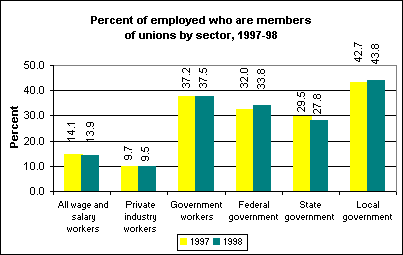An official website of the United States government
 United States Department of Labor
United States Department of Labor
The number of union members rose for the first time in five years, increasing from 16.1 million in 1997 to 16.2 million in 1998. Despite the rise in the number of members, the share of workers who were union members declined from 14.1 percent in 1997 to 13.9 percent in 1998.

[Chart data—TXT]
In 1998, about 9.3 million private industry workers were members of unions, little changed from 1997. In contrast, the number of government workers who were union members rose from more than 6.7 million to about 6.9 million. The increase in the number of public-sector union members occurred in both federal and local governments; state government union membership edged down.
The share of government workers who were union members rose over the year, while the private industry share fell. Government workers thus continue to have a much higher unionization rate than their private sector counterparts. Local government workers were the most likely to be unionized.
These data are a product of the Current Population Survey. More information can be found in news release USDL 99-21, "Union Members in 1998." Comparable union membership data have been reported by BLS since 1983.
Bureau of Labor Statistics, U.S. Department of Labor, The Economics Daily, Union membership edges up, but share continues to fall at https://www.bls.gov/opub/ted/1999/jan/wk4/art04.htm (visited December 21, 2025).

